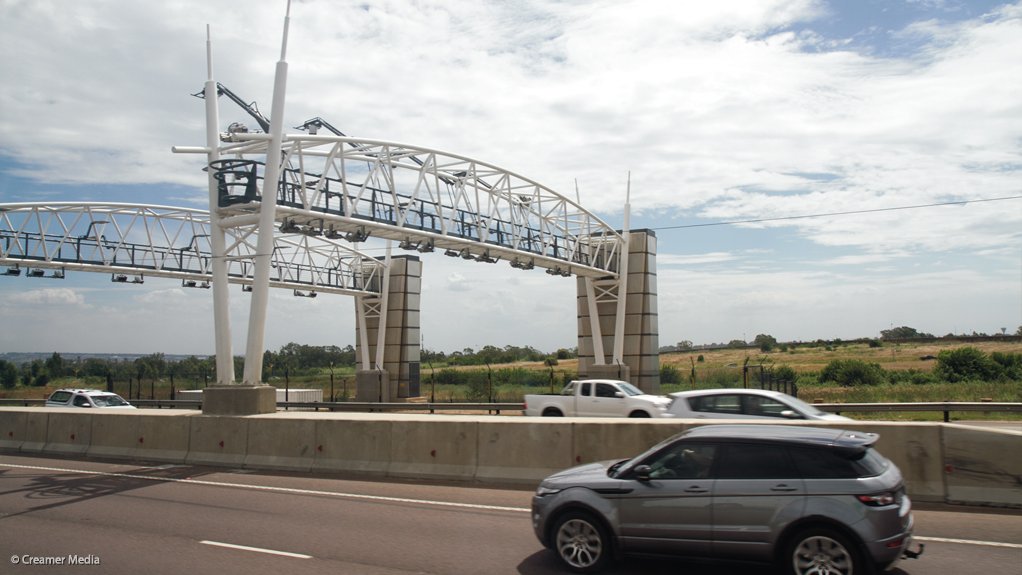Arguing in defence of the South African National Roads Agency Limited’s (Sanral’s) controversional e-toll user-pays system, transport economist Barry Standish has told the Advisory Panel on the Socioeconomic Impact of E-tolls that the long-term savings of e-tolls and the Gauteng Freeway Improvement project (GFIP) for commuters outweigh the associated costs and toll tarriffs.
Elaborating on a 2010 economic analysis report on the GFIP prepared by Standish for the Gauteng provincial government (GPG) and Sanral, the economist revealed that the project was delivering “out of pocket” savings to most users in the morning and evening peaks, as well as during daylight offpeak periods.
He asserted that, on average, the toll fees paid by commuters were “very small” compared with the province’s average household disposable income.
According to Standish, commuters paid 25c in toll tariffs for every R100 earned.
Toll fees were also progressive across income categories, meaning that the higher the income bracket, the more that income category contributed to overall toll revenues.
Commuters earning between R9 479 and R41 000 a month contributed some 99% of overall revenues.
“Of the total amount of tolls being collected, people earning up to R5 000 are [only] paying 1% of total revenues. It’s richer people that are paying the bulk,” he commented.
Moreover, tolls had a “very small” impact on the cost of food, increasing the price of consumables by between 4c and 17c for each R100 worth of food transported on e-tolled roads.
“[GFIP and e-tolls] are economically efficient from an international best practise approach and it’s one of the more efficient [global road infrastructure] projects we’ve worked on.
“There are cases where the toll is higher than the savings, but this can be mitigated by additional time-of-day savings and through the GFIP Phase 2. There are winners and losers, but the losers can be mitigated,” he said on Thursday.
Noting that there appeared to be a “disjoint” between the savings associated with the e-toll system and public perception, Standish said that, had there been no road upgrades or the GFIP had not been undertaken, the cost of Gauteng drivers’ daily commute would rise, owing to increases in out-of-pocket expenses, such as for fuel, tyres, oil and maintenance.
For example, without the GFIP, a driver commuting between Soweto and Isando on a daily basis would have seen the cost of their morning peak hour commute increase by R400 a month by 2018.
However, with the upgrades, commuters using this route in 2014 would see savings in running costs during the morning peak hour of R19.54, as well as 14 minutes in time-savings.
Considering the e-tag tarriff of R8.64 for this route, the net out-of-pocket saving was thus R10.90.
“So the benefit of GFIP is that, after the tolls, it’s actually saving people money, not costing them money. People have actually been experiencing the savings of the upgrades since 2010, but they’re only being asked to pay for it now,” he noted.
Standish, meanwhile, described e-toll revenue as “insignificant” in comparison to provincial gross domestic product (GDP), revealing that, if all road users were compliant and paid their e-toll bill, toll revenues would amount to R2.5-billion, or 0.19% of provincial GDP of R1.2-trillion.
“[This demonstrates] that GFIP, comparative to the wealth of Gauteng, is a blip on the horizon; its insignificant,” he said.
GFIP project manager Alex van Niekerk outlined in a later presentation to the panel on Thursday that tolled highways in Gauteng were “already” being used by over a million users every day.
As a result of the freeway upgrades, 81 000 vehicles hours had been saved, while this would increase to 492 000 hours by 2025.
He added that “initial project glitches” had largely been corrected.
As part of the GFIP, 201 km of highways had been upgraded in the province, while 585 km of additional lanes were added and 265 km of lanes fully reconstructed.
In addition, 34 interchanges were “significantly upgraded”, four new directional ramps or fly-overs and 477 new bridges were built, while 134 existing bridges were widened.
Freeway lighting was installed on 186 km of road and 127 km of concrete median barriers were added.
Van Niekerk added that, as part of the upgrade, guardrails and potholes would be fixed, litter collected, grass cut and lighting maintained.
Sanral expected to perform periodic maintenance, such as rehabilitation and overlays and had budgeted R2.9-billion for these upgrades between 2020 and 2030 and R8.8-billion from 2030 onwards.
The e-toll advisory panel had been tasked by Gauteng Premier David Makhura to investigate the socioeconomic impact of the tolling system on the province and was expected to present a final report and list of recommendations to the GPG by November 30.
EMAIL THIS ARTICLE SAVE THIS ARTICLE
To subscribe email subscriptions@creamermedia.co.za or click here
To advertise email advertising@creamermedia.co.za or click here











